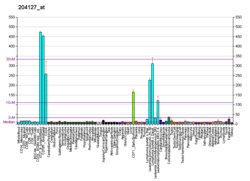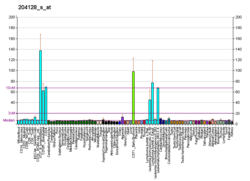RFC3
Replication factor C subunit 3 is a protein that in humans is encoded by the RFC3 gene.[5][6]
Function
The elongation of primed DNA templates by DNA polymerase delta and DNA polymerase epsilon requires the accessory proteins proliferating cell nuclear antigen (PCNA) and replication factor C (RFC). RFC, also named activator 1, is a protein complex consisting of five distinct subunits of 140, 40, 38, 37, and 36 kDa. This gene encodes the 38 kDa subunit. This subunit is essential for the interaction between the 140 kDa subunit and the core complex that consists of the 36, 37, and 40 kDa subunits. Alternatively spliced transcript variants encoding distinct isoforms have been described.[6]
Interactions
RFC3 has been shown to interact with:
gollark: Tenstorrent and whatever.
gollark: There are some companies with specialized hardware for ML which might compete with Nvidia.
gollark: The price is probably going to come down. Eventually.
gollark: How affordable*!\* not affordable
gollark: It probably couldn't work at all without that, but still.
References
- GRCh38: Ensembl release 89: ENSG00000133119 - Ensembl, May 2017
- GRCm38: Ensembl release 89: ENSMUSG00000033970 - Ensembl, May 2017
- "Human PubMed Reference:". National Center for Biotechnology Information, U.S. National Library of Medicine.
- "Mouse PubMed Reference:". National Center for Biotechnology Information, U.S. National Library of Medicine.
- Okumura K, Nogami M, Taguchi H, Dean FB, Chen M, Pan ZQ, Hurwitz J, Shiratori A, Murakami Y, Ozawa K (Jan 1995). "Assignment of the 36.5-kDa (RFC5), 37-kDa (RFC4), 38-kDa (RFC3), and 40-kDa (RFC2) subunit genes of human replication factor C to chromosome bands 12q24.2-q24.3, 3q27, 13q12.3-q13, and 7q11.23". Genomics. 25 (1): 274–8. doi:10.1016/0888-7543(95)80135-9. PMID 7774928.
- "Entrez Gene: RFC3 replication factor C (activator 1) 3, 38kDa".
- Maruyama T, Farina A, Dey A, Cheong J, Bermudez VP, Tamura T, Sciortino S, Shuman J, Hurwitz J, Ozato K (Sep 2002). "A Mammalian bromodomain protein, brd4, interacts with replication factor C and inhibits progression to S phase". Molecular and Cellular Biology. 22 (18): 6509–20. doi:10.1128/mcb.22.18.6509-6520.2002. PMC 135621. PMID 12192049.
- Bermudez VP, Maniwa Y, Tappin I, Ozato K, Yokomori K, Hurwitz J (Sep 2003). "The alternative Ctf18-Dcc1-Ctf8-replication factor C complex required for sister chromatid cohesion loads proliferating cell nuclear antigen onto DNA". Proceedings of the National Academy of Sciences of the United States of America. 100 (18): 10237–42. doi:10.1073/pnas.1434308100. PMC 193545. PMID 12930902.
- Merkle CJ, Karnitz LM, Henry-Sánchez JT, Chen J (Aug 2003). "Cloning and characterization of hCTF18, hCTF8, and hDCC1. Human homologs of a Saccharomyces cerevisiae complex involved in sister chromatid cohesion establishment". The Journal of Biological Chemistry. 278 (32): 30051–6. doi:10.1074/jbc.M211591200. PMID 12766176.
- Ohta S, Shiomi Y, Sugimoto K, Obuse C, Tsurimoto T (Oct 2002). "A proteomics approach to identify proliferating cell nuclear antigen (PCNA)-binding proteins in human cell lysates. Identification of the human CHL12/RFCs2-5 complex as a novel PCNA-binding protein". The Journal of Biological Chemistry. 277 (43): 40362–7. doi:10.1074/jbc.M206194200. PMID 12171929.
- Ellison V, Stillman B (Mar 1998). "Reconstitution of recombinant human replication factor C (RFC) and identification of an RFC subcomplex possessing DNA-dependent ATPase activity". The Journal of Biological Chemistry. 273 (10): 5979–87. doi:10.1074/jbc.273.10.5979. PMID 9488738.
- Uhlmann F, Cai J, Flores-Rozas H, Dean FB, Finkelstein J, O'Donnell M, Hurwitz J (Jun 1996). "In vitro reconstitution of human replication factor C from its five subunits". Proceedings of the National Academy of Sciences of the United States of America. 93 (13): 6521–6. doi:10.1073/pnas.93.13.6521. PMC 39056. PMID 8692848.
- Tomida J, Masuda Y, Hiroaki H, Ishikawa T, Song I, Tsurimoto T, Tateishi S, Shiomi T, Kamei Y, Kim J, Kamiya K, Vaziri C, Ohmori H, Todo T (Apr 2008). "DNA damage-induced ubiquitylation of RFC2 subunit of replication factor C complex". The Journal of Biological Chemistry. 283 (14): 9071–9. doi:10.1074/jbc.M709835200. PMC 2431014. PMID 18245774.
Further reading
- Maruyama K, Sugano S (Jan 1994). "Oligo-capping: a simple method to replace the cap structure of eukaryotic mRNAs with oligoribonucleotides". Gene. 138 (1–2): 171–4. doi:10.1016/0378-1119(94)90802-8. PMID 8125298.
- O'Donnell M, Onrust R, Dean FB, Chen M, Hurwitz J (Jan 1993). "Homology in accessory proteins of replicative polymerases--E. coli to humans". Nucleic Acids Research. 21 (1): 1–3. doi:10.1093/nar/21.1.1. PMC 309057. PMID 8441605.
- Uhlmann F, Cai J, Flores-Rozas H, Dean FB, Finkelstein J, O'Donnell M, Hurwitz J (Jun 1996). "In vitro reconstitution of human replication factor C from its five subunits". Proceedings of the National Academy of Sciences of the United States of America. 93 (13): 6521–6. doi:10.1073/pnas.93.13.6521. PMC 39056. PMID 8692848.
- Uhlmann F, Cai J, Gibbs E, O'Donnell M, Hurwitz J (Apr 1997). "Deletion analysis of the large subunit p140 in human replication factor C reveals regions required for complex formation and replication activities". The Journal of Biological Chemistry. 272 (15): 10058–64. doi:10.1074/jbc.272.15.10058. PMID 9092549.
- Cujec TP, Cho H, Maldonado E, Meyer J, Reinberg D, Peterlin BM (Apr 1997). "The human immunodeficiency virus transactivator Tat interacts with the RNA polymerase II holoenzyme". Molecular and Cellular Biology. 17 (4): 1817–23. doi:10.1128/MCB.17.4.1817. PMC 232028. PMID 9121429.
- Cai J, Gibbs E, Uhlmann F, Phillips B, Yao N, O'Donnell M, Hurwitz J (Jul 1997). "A complex consisting of human replication factor C p40, p37, and p36 subunits is a DNA-dependent ATPase and an intermediate in the assembly of the holoenzyme". The Journal of Biological Chemistry. 272 (30): 18974–81. doi:10.1074/jbc.272.30.18974. PMID 9228079.
- Suzuki Y, Yoshitomo-Nakagawa K, Maruyama K, Suyama A, Sugano S (Oct 1997). "Construction and characterization of a full length-enriched and a 5'-end-enriched cDNA library". Gene. 200 (1–2): 149–56. doi:10.1016/S0378-1119(97)00411-3. PMID 9373149.
- Ellison V, Stillman B (Mar 1998). "Reconstitution of recombinant human replication factor C (RFC) and identification of an RFC subcomplex possessing DNA-dependent ATPase activity". The Journal of Biological Chemistry. 273 (10): 5979–87. doi:10.1074/jbc.273.10.5979. PMID 9488738.
- Zhang G, Gibbs E, Kelman Z, O'Donnell M, Hurwitz J (Mar 1999). "Studies on the interactions between human replication factor C and human proliferating cell nuclear antigen". Proceedings of the National Academy of Sciences of the United States of America. 96 (5): 1869–74. doi:10.1073/pnas.96.5.1869. PMC 26703. PMID 10051561.
- Rauen M, Burtelow MA, Dufault VM, Karnitz LM (Sep 2000). "The human checkpoint protein hRad17 interacts with the PCNA-like proteins hRad1, hHus1, and hRad9". The Journal of Biological Chemistry. 275 (38): 29767–71. doi:10.1074/jbc.M005782200. PMID 10884395.
- Lindsey-Boltz LA, Bermudez VP, Hurwitz J, Sancar A (Sep 2001). "Purification and characterization of human DNA damage checkpoint Rad complexes". Proceedings of the National Academy of Sciences of the United States of America. 98 (20): 11236–41. doi:10.1073/pnas.201373498. PMC 58713. PMID 11572977.
- Griffith JD, Lindsey-Boltz LA, Sancar A (May 2002). "Structures of the human Rad17-replication factor C and checkpoint Rad 9-1-1 complexes visualized by glycerol spray/low voltage microscopy". The Journal of Biological Chemistry. 277 (18): 15233–6. doi:10.1074/jbc.C200129200. PMID 11907025.
- Ohta S, Shiomi Y, Sugimoto K, Obuse C, Tsurimoto T (Oct 2002). "A proteomics approach to identify proliferating cell nuclear antigen (PCNA)-binding proteins in human cell lysates. Identification of the human CHL12/RFCs2-5 complex as a novel PCNA-binding protein". The Journal of Biological Chemistry. 277 (43): 40362–7. doi:10.1074/jbc.M206194200. PMID 12171929.
- Maruyama T, Farina A, Dey A, Cheong J, Bermudez VP, Tamura T, Sciortino S, Shuman J, Hurwitz J, Ozato K (Sep 2002). "A Mammalian bromodomain protein, brd4, interacts with replication factor C and inhibits progression to S phase". Molecular and Cellular Biology. 22 (18): 6509–20. doi:10.1128/MCB.22.18.6509-6520.2002. PMC 135621. PMID 12192049.
- Merkle CJ, Karnitz LM, Henry-Sánchez JT, Chen J (Aug 2003). "Cloning and characterization of hCTF18, hCTF8, and hDCC1. Human homologs of a Saccharomyces cerevisiae complex involved in sister chromatid cohesion establishment". The Journal of Biological Chemistry. 278 (32): 30051–6. doi:10.1074/jbc.M211591200. PMID 12766176.
- Bermudez VP, Maniwa Y, Tappin I, Ozato K, Yokomori K, Hurwitz J (Sep 2003). "The alternative Ctf18-Dcc1-Ctf8-replication factor C complex required for sister chromatid cohesion loads proliferating cell nuclear antigen onto DNA". Proceedings of the National Academy of Sciences of the United States of America. 100 (18): 10237–42. doi:10.1073/pnas.1434308100. PMC 193545. PMID 12930902.
- Zou L, Liu D, Elledge SJ (Nov 2003). "Replication protein A-mediated recruitment and activation of Rad17 complexes". Proceedings of the National Academy of Sciences of the United States of America. 100 (24): 13827–32. doi:10.1073/pnas.2336100100. PMC 283506. PMID 14605214.
This article is issued from Wikipedia. The text is licensed under Creative Commons - Attribution - Sharealike. Additional terms may apply for the media files.





